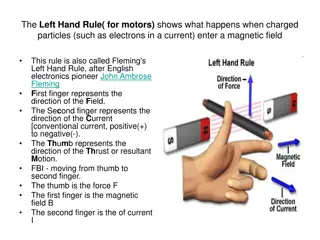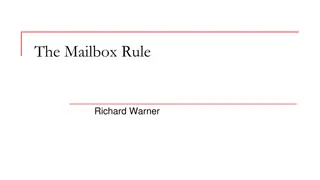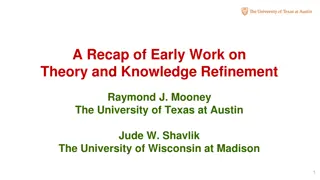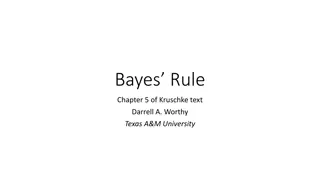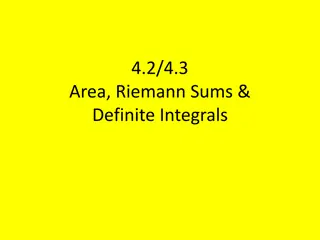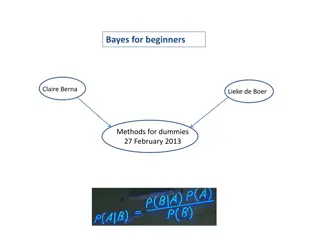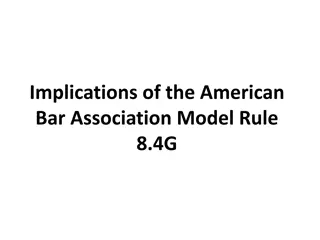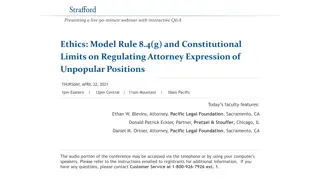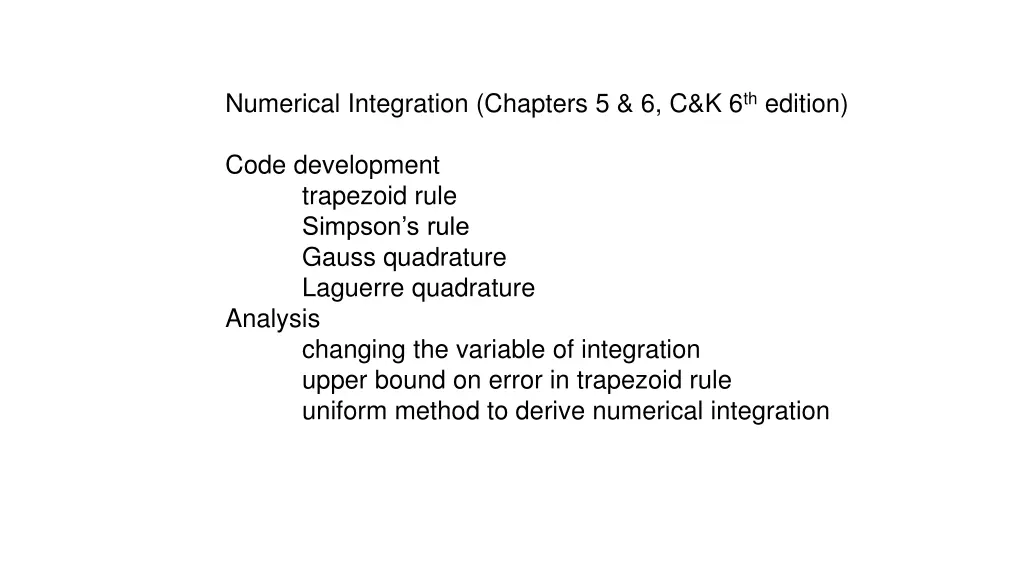
Numerical Integration Techniques and Methods
Explore the development of numerical integration methods such as the trapezoid rule, Simpson's rule, Gauss quadrature, and Laguerre quadrature. Learn how to derive and implement the trapezoid rule in MATLAB, with a focus on evaluating integrands at arbitrary points for accurate approximations. Delve into solving integrals using the trapezoid rule with a specific example and comparing it to the exact value to measure accuracy.
Download Presentation

Please find below an Image/Link to download the presentation.
The content on the website is provided AS IS for your information and personal use only. It may not be sold, licensed, or shared on other websites without obtaining consent from the author. If you encounter any issues during the download, it is possible that the publisher has removed the file from their server.
You are allowed to download the files provided on this website for personal or commercial use, subject to the condition that they are used lawfully. All files are the property of their respective owners.
The content on the website is provided AS IS for your information and personal use only. It may not be sold, licensed, or shared on other websites without obtaining consent from the author.
E N D
Presentation Transcript
Numerical Integration (Chapters 5 & 6, C&K 6th edition) Code development trapezoid rule Simpson s rule Gauss quadrature Laguerre quadrature Analysis changing the variable of integration upper bound on error in trapezoid rule uniform method to derive numerical integration
Replace integrand f(x) on [a,b] by line p(x) b + f(a) f(b) Area of a trapezoid f(x)dx (b a) 2 a Multiple intervals with f(x) on [xk-1,xk] replaced by a line b + f(x ) f(x ) n k f(x)dx (x - x ) k 1 - k k 1 - k 2 = 2 a Usually, x1 = a and xn = b
MatLab code for trapezoid rule with integrand evaluated at n arbitrary points in the range of integration: b + f(x ) f(x ) n k f(x)dx (x - x ) k 1 - k k 1 - x 2 = 2 a Basic idea: Input 2 arrays of length n: x = values where the integrand is evaluated. f = values of the integrand at those points In a for-loop, accumulate the area of n-1 trapezoids Output sum as trapezoid rule approximation to integral
MatLab code for trapezoid rule integration with integrand evaluated at n arbitrary points in the range of integration function A=arbitrary_spacing(x,f) n=length(x); sum=0; for k=2:n end A=sum; end sum=sum+(x(k)-x(k-1))*(f(k)+f(k-1))/2; Download arbitrary_spacing.m from class web page
5 1 exp(-x)dx We will approximate by the trapezoid rule in several forms and compare their accuracy as percent difference from the exact value. How do we find the exact value of an integral? What is the anti-derivative of e-x ?
5 1 exp(-x)dx Write a script to apply trapezoid rule function to estimate with 10 equally spaced points and compare to exact value as absolute percent difference. Pseudocode: Function handle for integrand Exact value from anti-derivative = e-1 e-5 Vector of x values where integrand will be evaluated Call to arbitrary_spacing.m with arguments x and integrand(x) Calculate ercent absolute difference Display exact, trap approximation, and percent difference
MatLab script to apply trapezoid rule function 5 exp(-x)dx 1 to estimate with 10 equally spaced points. integrand=@(x) exp(-x); exact=exp(-1)-exp(-5); x=linspace(1,5,10); A1=arbitrary_spacing(x,integrand(x)); PD1=100*abs((A1-exact)/exact); disp([A1,exact, PD1]) Run this script
Accuracy of numerical integration depends on where the integrand is evaluated. Since e-x is rapidly decreasing, expect some advantage of more points near 1 and less near 5. 5 1 exp(-x)dx Write a script to estimate with 10 logarithmically spaced points between 1 and 5. To get logarithmic spacing, define y vector with 10 equally spacing points between 0 and ln(5). Get new x vector newx=exp(y). Modify previous script to get the absolute percent difference from exact.
MATLAB script to apply trapezoid rule function 5 1 to estimate with logarithmically spaced points exp(-x)dx integrand=@(x) exp(-x); exact=exp(-1)-exp(-5); y=linspace(0,log(5),10); newx=exp(y); A2 = arbitrary_spacing(newx,integrand(newx)); PD2 = 100*abs((A2-exact)/exact); disp([A2, exact, PD2) Run this script
What is the difference between the two choices of where the integrand is evaluated? Plot the 2 choices
equal spacing x-value log spacing index
Use the transformation y = ln(x) to change the variable of integration. dy = dx/x dx=x(y)dy ln( ) 5 exp( 5 = exp ( )) ( ) (-x)dx x y x y dy 1 0 x(y)= exp(y) Integrand is a function of y through x(y)
Write a script to approximate ln( ) 5 exp( 5 = exp ( )) ( ) (-x)dx x y x y dy 1 0 x(y)= exp(y) using the integration variable y with 10 equally spaced points between 0 and ln(5), estimate integral without make the integrand an explicit function of y. Pseudocode function_handle for e-x exact value vector of y_values vector xofy = ey arbitrary_spacing(y_values, function_handle(xofy).*xofy absolute percent difference from exact display
5 1 exp(-x)dx MATLAB script to apply trapezoid rule to approximate with a new integration variable y=ln(x). integrand=@(x) exp(-x); exact=exp(-1)-exp(-5); y=linspace(0,log(5),10); xofy=exp(y); A3 = arbitrary_spacing(y, xofy.*integrand(xofy)); PD3=100*abs((A3-exact)/exact); disp([A3,exact,PD3]) Run this script
5 1 exp(-x)dx Summary of results to estimate by the trapezoid rule with 10 points when the points are chosen in the following ways: 1. Equally spaced on [1, 5] 2. Logarithmically spaced [1, 5] 3. Equally spaced on [0, ln(5)] in the new integration variable y = ln(x). Results for percent difference: (1) 1.6407, (2) 1.1756, (3) 0.0995
What we learned from this exercise For a given numerical integration method and a specified number of points, additional factors affect the accuracy of approximation. Two important factors are: 1. Where the integrand is evaluated. 2. Which integration variable is used.
Assignment 5 3 100 10 1 sin( )dx x x Assume -18.79829683678703 is the exact value of the integral. Estimate this integral by the trapezoid rule with 10 points when the points are chosen in the following ways: 1. Equally spaced on [1, 3] 2. Logarithmically spaced [1, 3] 3. Equally spaced on [0, ln(3)] in the new integration variable y = ln(x). Calculate the absolute percent difference,100*abs((A-exact)/exact), from the exact value in each case. Hand in a copy of command window that shows your scripts and results.





